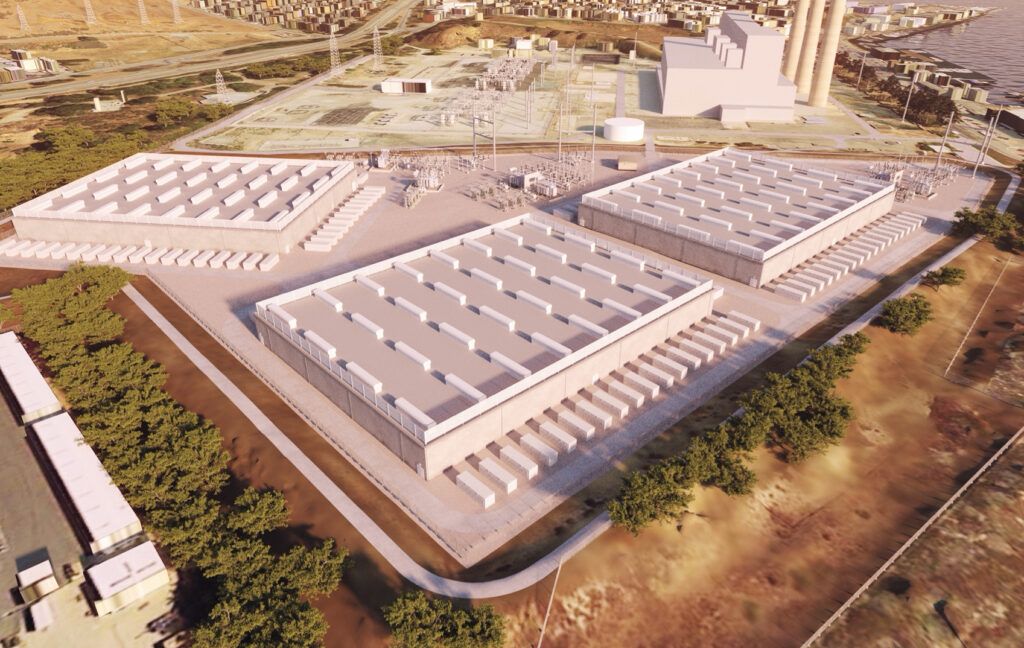$600 million battery storage project meets resistance in California
By Erin Rode | May 30, 2024
 An artist’s conception of the proposed battery storage project, formerly the site of the power plant’s tank farm. Image courtesy of Vistra Corp.
An artist’s conception of the proposed battery storage project, formerly the site of the power plant’s tank farm. Image courtesy of Vistra Corp.
Editor’s note: This story was originally published by Inside Climate News. It appears here as part of the Climate Desk collaboration.
By some criteria, 1290 Embarcadero in Morro Bay, Calif. seems like a prime site for a facility to store renewable energy.
This swath of coastal land houses a power plant that was shuttered a decade ago and its still standing smokestacks. Vistra Corp.’s proposal for a 600-megawatt battery storage project on a portion of the site includes remediating the entire area and removing the plant and stacks, readying the land for future development. And the site’s history as a power plant means it’s well-positioned to connect to existing transmission lines. Vistra estimates the project will cost between $500 and $600 million.
“The location is fantastic, and certainly the need is there in the California grid,” said Mark McDaniels, Vistra’s vice president of renewables and storage, at an April 24 community meeting.
But some locals in the small city on California’s Central Coast disagree, and placed a measure on the ballot this fall that could impact the project’s future. Project opponents say they’re concerned about its impacts on tourism and the potential for fires at the facility, with one resident calling the proposal a “toxic bomb” during the meeting.
California recently surpassed 10,000 megawatts of battery storage capacity, marking a 1,250 percent increase since 2019. At one point on April 19, batteries were the largest source of power to the state’s grid for the first time. And in the inland Southern California town of Menifee, a 680-megawatt storage project replacing an old gas plant will be among the largest battery reserves in the United States.
California draws a growing share of its electricity from the sun during the day, but the sun sets as Californians come home from work and turn the lights on, creating demand that usually must be filled by fossil fuels. Battery storage allows power companies to generated by solar panels and windmills for when the sun isn’t shining and breezes are calm.
The state still will need nearly 42,000 additional megawatts of energy storage capacity by 2045 to meet its goal of using 100-percent clean electricity that year. But in some communities like Morro Bay, proposed storage projects have been met with heated opposition.
This local pushback demonstrates the tension between the desire for “really high quality local permitting” and the state’s push for “really rapid transformation of the whole electricity grid and rapid deployment of energy storage,” which will require the speedy issuing of permits, said Mariko Geronimo Aydin, co-founder and chief energy economist at Lumen Energy Strategy, which last year completed an analysis of the state of battery storage in the state for the California Public Utilities Commission.
“I think ultimately, we want to have both; we don’t want one at the expense of the other,” said Geronimo Aydin.
Vistra Corp. proposed the Morro Bay battery storage project in 2020, and the project is currently in the draft environmental impact report stage, with that document open for public comments through the end of May. The project is awaiting consideration by the city’s planning commission and city council.
But the ballot measure put forth by local opposition group Citizens for Estero Bay Preservation would reroute that process by requiring approval by a majority of voters. Last year, the group gathered enough signatures—10 percent of the city’s registered voters—to place Measure A-24 on the ballot.
Back in 2021, the city changed the land-use designation of the shuttered power plant from “Industrial” to “Visitor Serving/Commercial,” and for the energy storage project to move forward, the city council would need to vote to change the designation to again allow industrial uses. If the ballot measure is approved, it would freeze the current land-use designation of the property and a few others in the area and then require a majority of voters to approve another change in the land-use designation.
“We felt that kind of facility basically in the center of our tourist area is inappropriate. Our whole town is based on the tourism economy,” said Barry Branin, a member of the group behind the ballot measure.
Instead, he says the battery storage project should go somewhere more inland in the agricultural valleys east of Morro Bay, or “out in the middle of the desert somewhere,” near existing renewable energy projects.
“All of the people from the valley like to come to Morro Bay, and if I knew there was going to be a battery facility. . . I wouldn’t want to bring my family to Morro Rock,” said Branin. “So why deprive the rest of the state of the use of the coast for some economic reason?”
Branin also argues that inland residents use more air conditioning than people living on the coast, so “the batteries should be near the users who have the air conditioners that are really demanding the electricity (at night).”
The argument underlies a key intersection of California’s climate and housing crises: For years, housing development has stagnated along the generally wealthier coasts as residents resist new development, pushing more Californians inland to communities at higher risk of extreme heat events.
Vistra says the project would support both the state’s energy needs and the local community.
“Our proposed plan puts ratepayers and residents of Morro Bay first by utilizing pre-existing interconnection infrastructure, while allowing for the eventual master planning and redevelopment of the remaining property to improve the Embarcadero area and allow for increased public access for the benefit of future generations,” reads a statement attributed to Claudia Morrow, senior vice president of development for Vistra.
And not building large-scale storage at sites with existing transmission infrastructure like the former power plant in Morro Bay “would lead to higher costs for the electricity system as a whole,” said Geronimo Aydin.
Citizens for Estero Bay also cites concerns over potential fires at the battery facility, pointing to the nearby example of Vistra’s Moss Landing in Monterey County, where in September 2022 a faulty smoke detector triggered water releases on the battery racks, which caused short circuits. The facility was then offline for months.
A community safety report commissioned by Vistra for the Morro Bay project found “no significant risk to the community,” determining that if a fire burned at the facility while wind blew the emissions toward nearby homes, the fire wouldn’t release enough toxins to cause a significant health risk. But that’s done little to quell concerns from community members, who filed into a recent community meeting holding up blue “Yes on Measure A-24 signs.”
Safety events at battery storage facilities are “relatively rare” across the United States, impacting between 1 to 2 percent of systems, and tend to occur in the first couple years of operation, according to Geronimo Aydin. The estimate applies to the industry “while it was in its pilot and demonstration phase,” and she says the industry has since standardized and improved safety best practices. But clearly and accurately communicating the potential risks to local residents and other stakeholders is still a big barrier for the industry.
“Now we’re at a position where safety risks and how to manage them are very well understood by those who work in the space, but the challenge now is to communicate exactly what that risk is, that it’s manageable risk and how to manage it,” said Geronimo Aydin.
Branin says he’s confident the ballot measure will succeed. But new legislation that allows large battery storage facilities to opt in to an approval process from the California Energy Commission (CEC), instead of going through a local process, could provide a backup pathway to Vistra.
Vistra didn’t respond to questions about how the ballot measure might impact the project, and at the April 24 community meeting a Vistra representative only said the company is focused on the project and the current process from the city.
“The applicant says they’re committed to the city’s process, and we’re working with them in good faith on that,” said Michael Codron, the city’s interim director of community development. “If the city’s process results in a denial or if the ballot measure precludes the ability of the city council to approve the application, I would think they would avail themselves of the CEC process.”

Together, we make the world safer.
The Bulletin elevates expert voices above the noise. But as an independent nonprofit organization, our operations depend on the support of readers like you. Help us continue to deliver quality journalism that holds leaders accountable. Your support of our work at any level is important. In return, we promise our coverage will be understandable, influential, vigilant, solution-oriented, and fair-minded. Together we can make a difference.
Keywords: batteries, battery storage, climate change, energy storage, renewable energy
Topics: Climate Change















